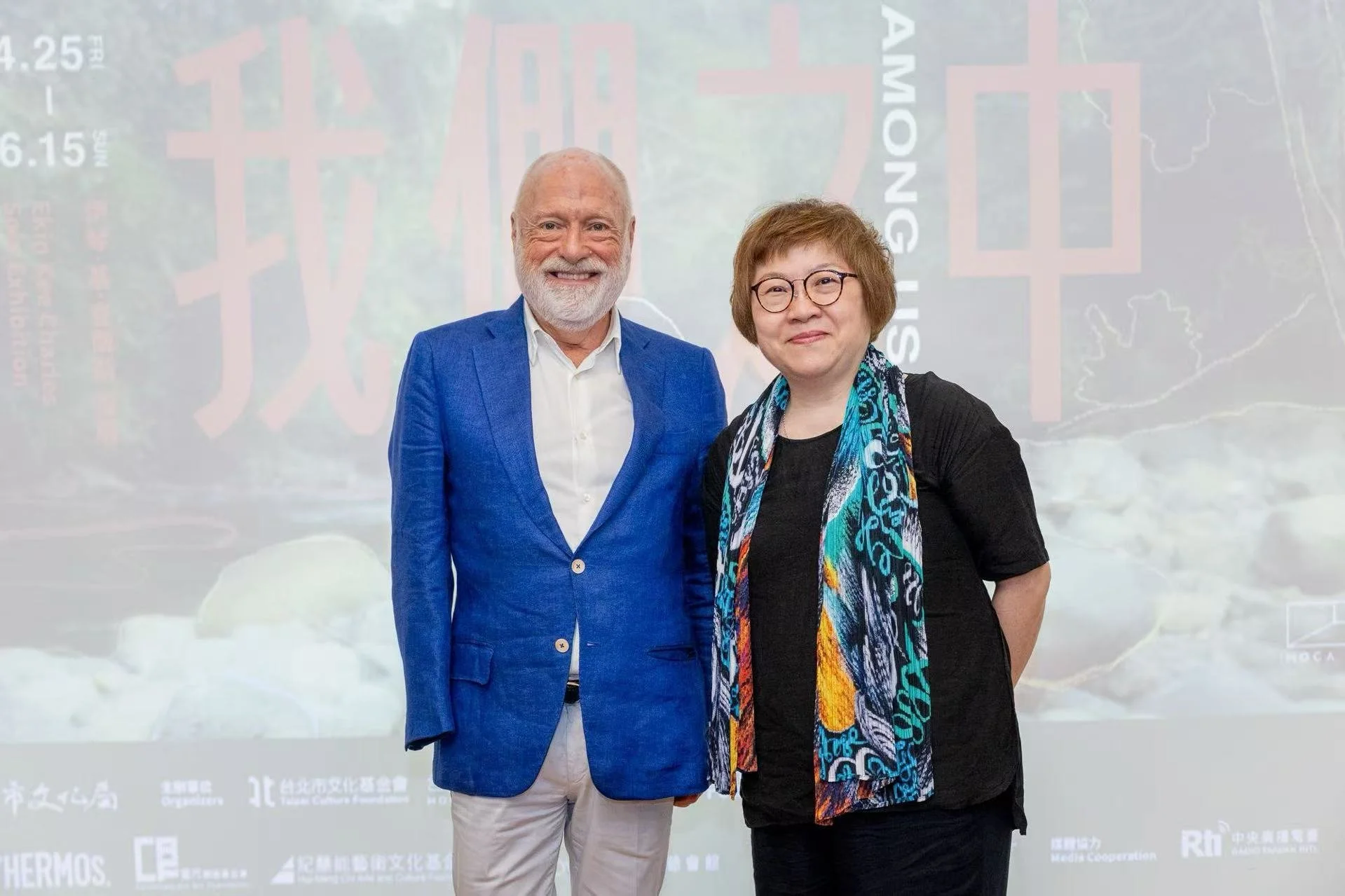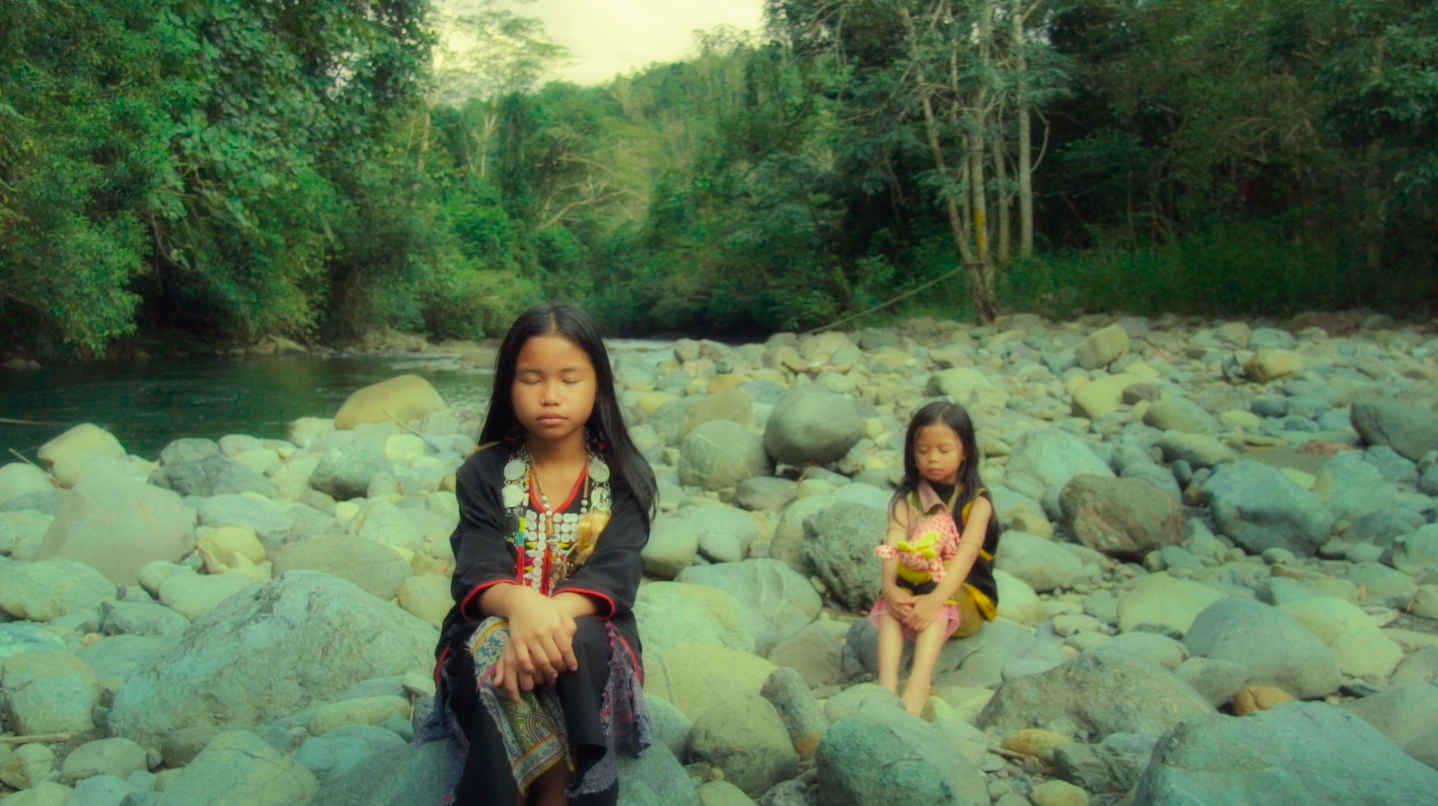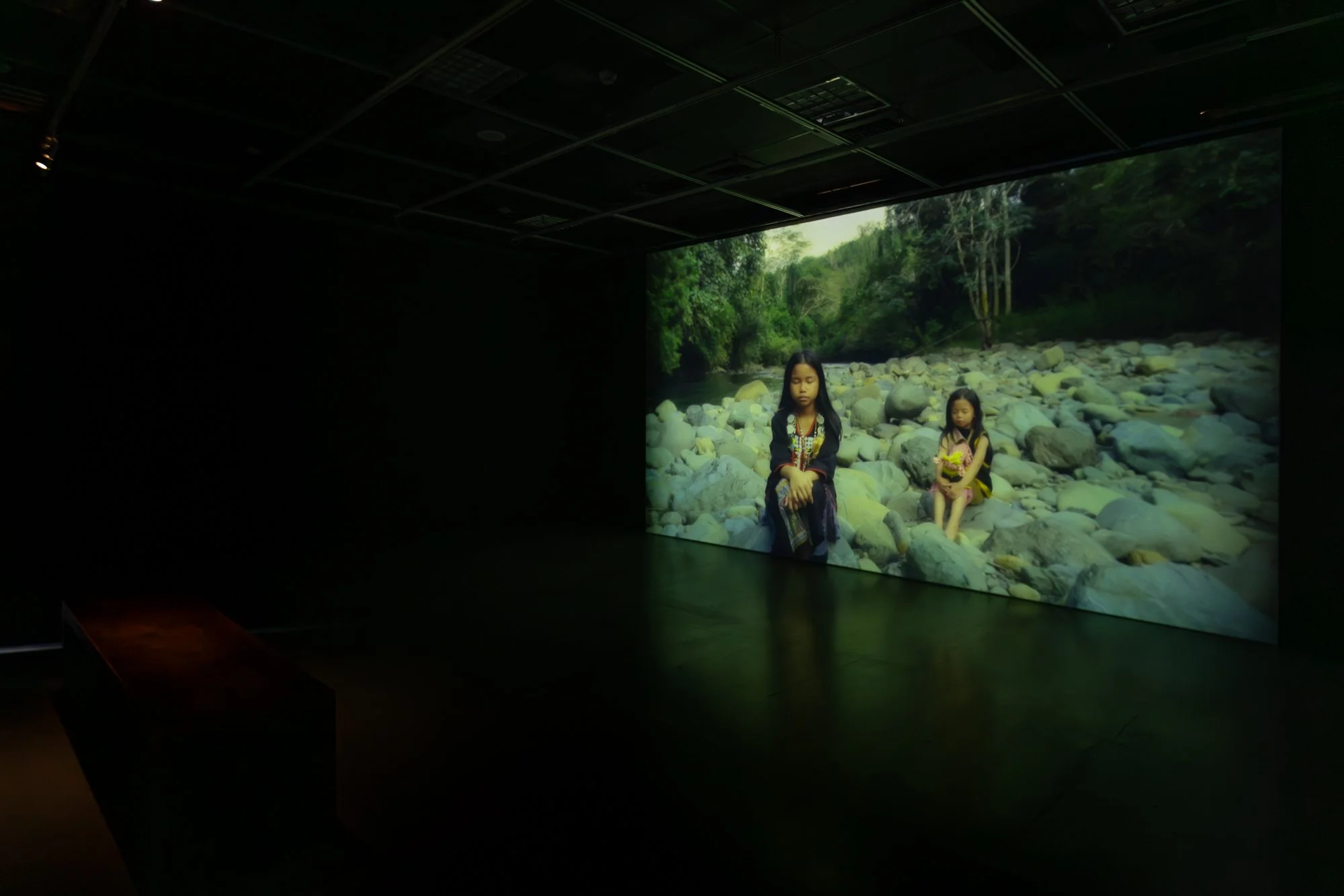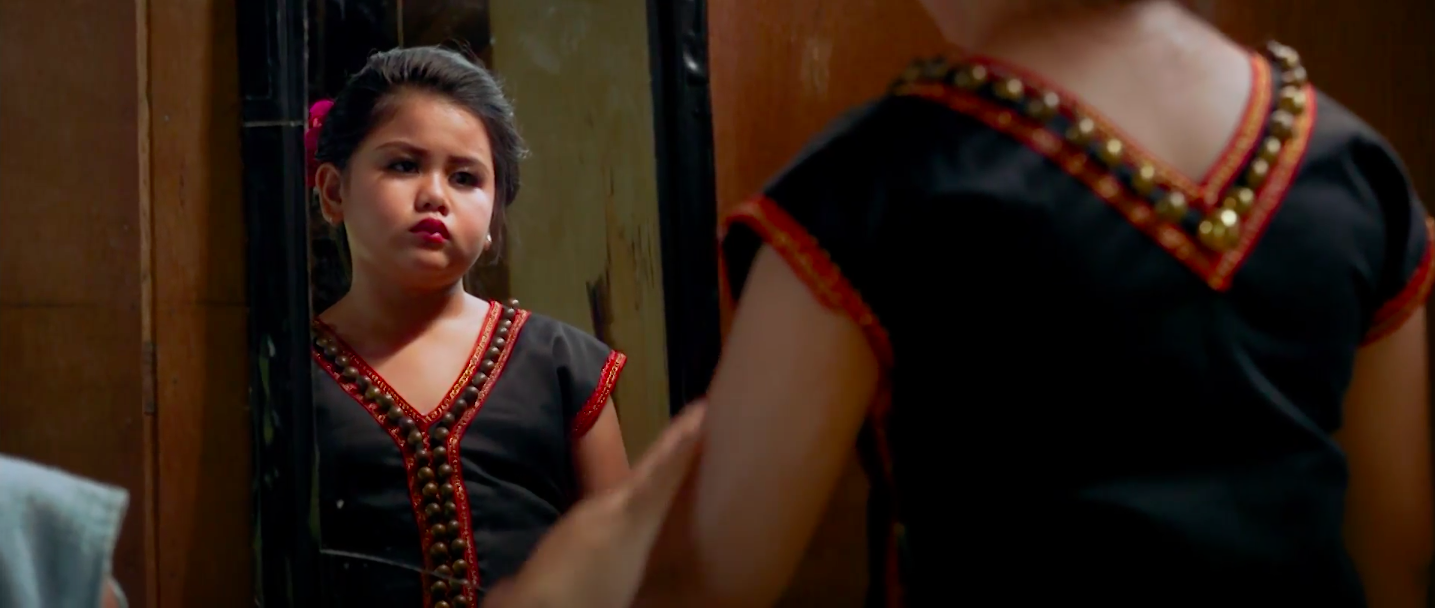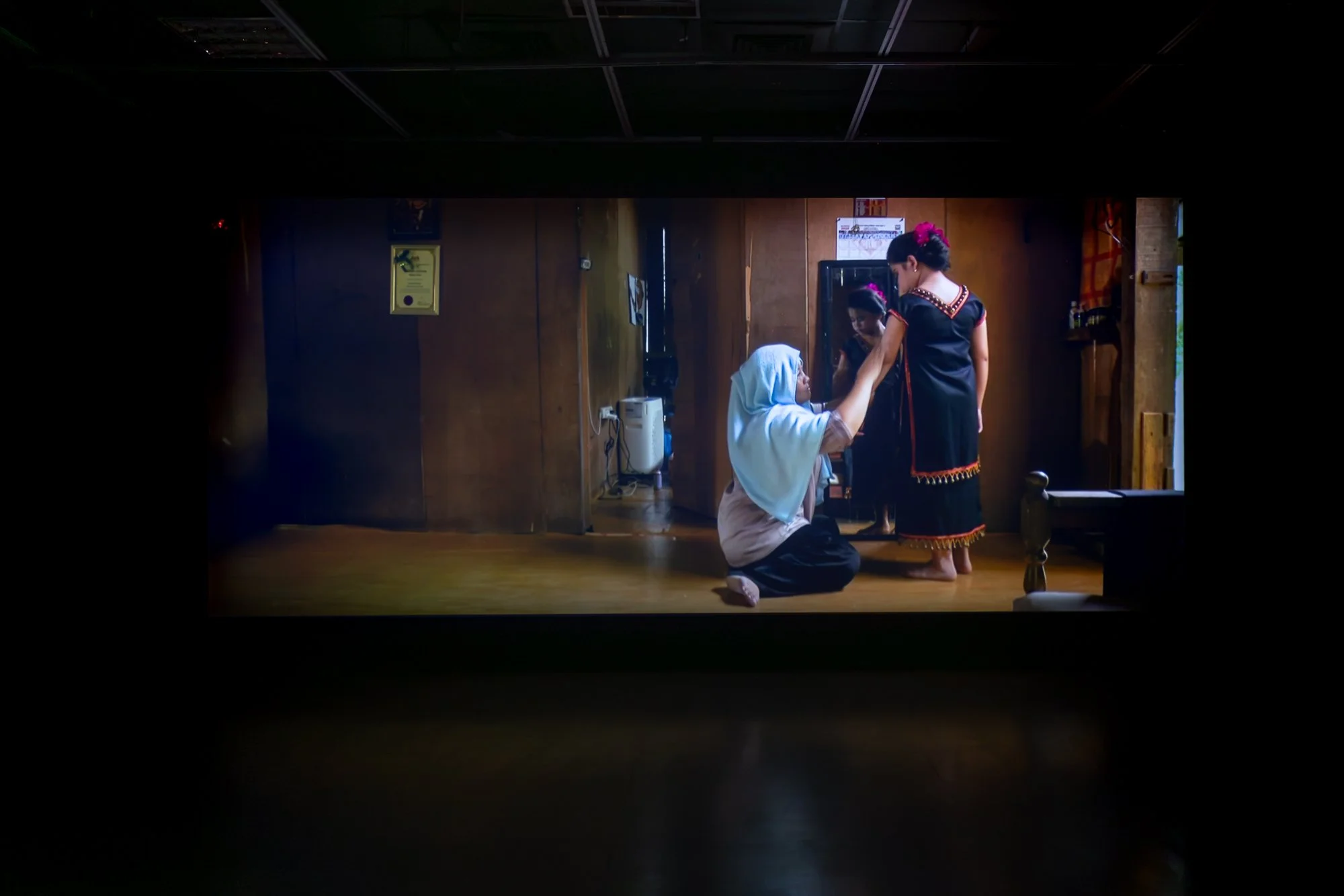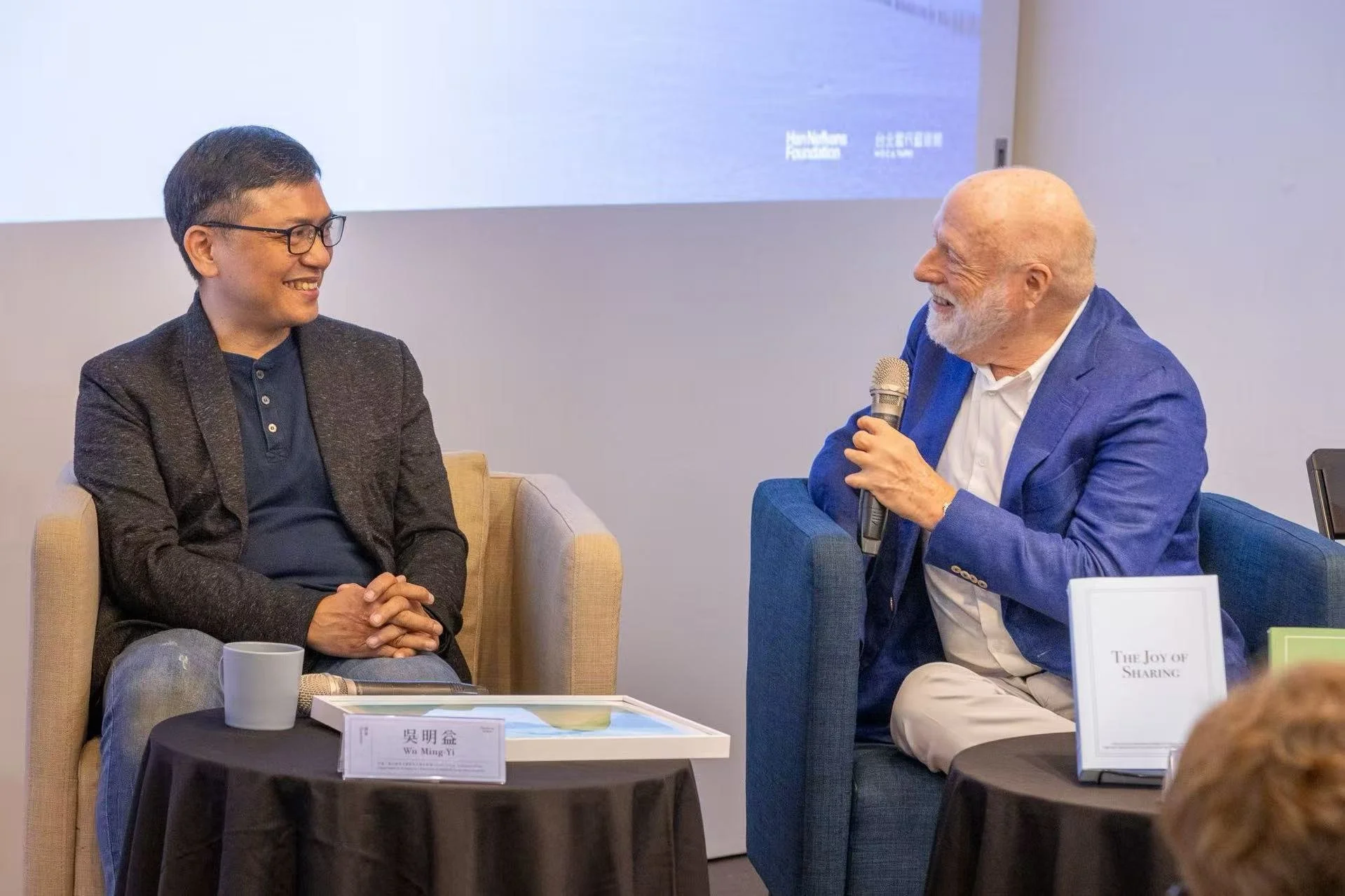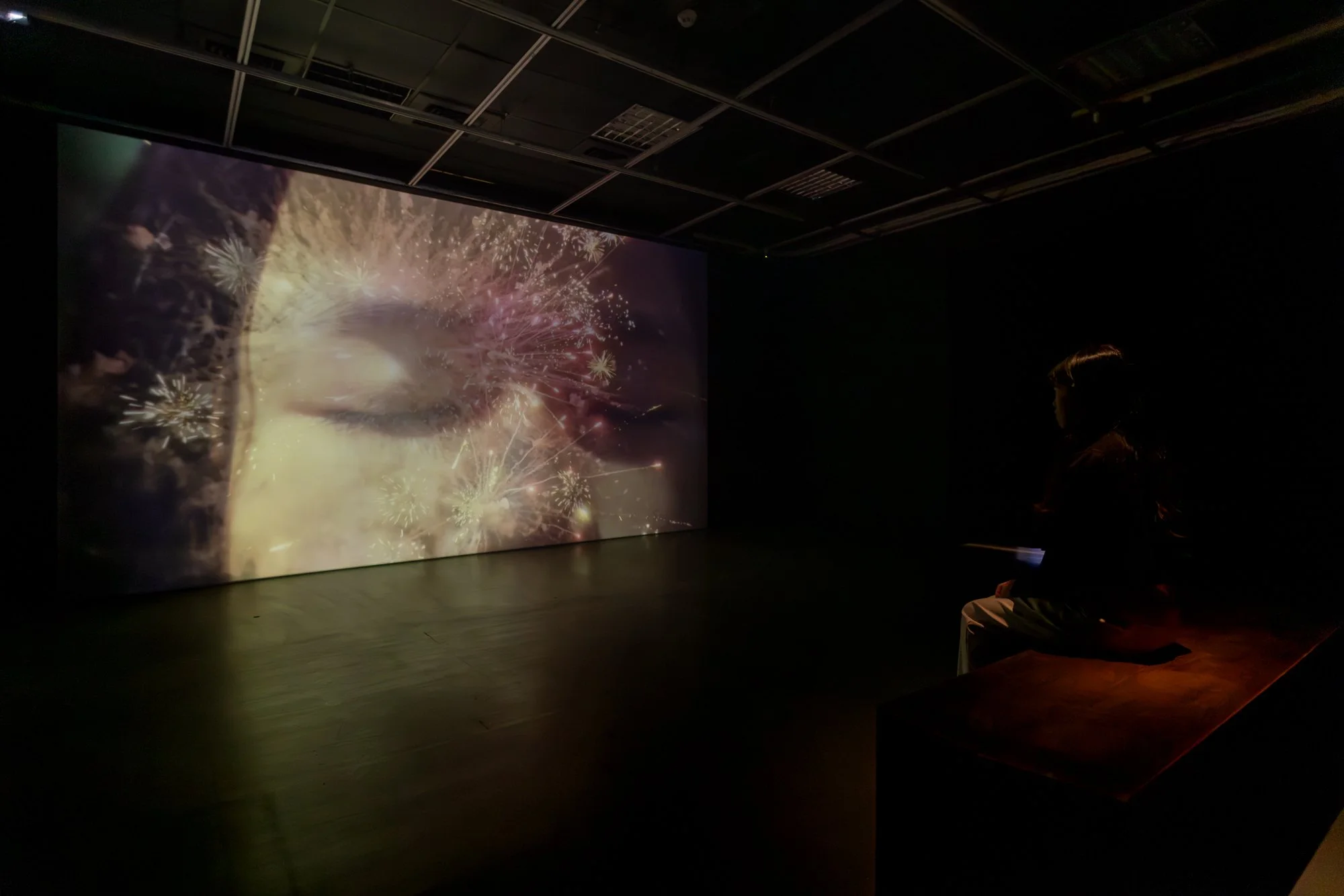Hanyin Xu, on Halos in the Crevice: From Beauty Pageants to Traditional Rituals | Among Us — Ekin Kee Charles Solo Exhibition
Within the cultural folds of Sabah’s Indigenous communities in Malaysia, artist Ekin Kee Charles wields her lens with an almost anthropological honesty, documenting a quiet collapse and rebirth. From April 25 to June 15, the Museum of Contemporary Art Taipei presents her first solo exhibition, Among Us, where two video works—Moth and Meet Me at the Ridge: 6.0753° N, 116.5588° E—serve as prisms refracting the intricate spectrum of Indigenous cultural transmission in the tides of globalization. Supported by the Han Nefkens Foundation for Video Art in collaboration with five international art institutions, the exhibition unfolds as both an experiment in personal memory and a cross-geographic cultural conspiracy, inviting audiences into the perpetual contest over what we call “authenticity.”
A photo of Han Nefkens, founder of the Han Nefkens Foundation for Video Art (left), and Ms. Loh Li-chen, Director of the Museum of Contemporary Art Taipei (right). Image courtesy of the Museum of Contemporary Art Taipei.
Everyday Folds: From Buffalo Skulls to Pixel Cemeteries
In the lens of Ekin Kee Charles, cultural transmission no longer appears as a solemn handover ceremony but instead emerges as a slow-growing web of everyday gestures. The artist, who describes herself as “not qualified to represent culture,” turns that very self-doubt into sustenance, nurturing some of the most honest survival samples of contemporary Indigenous youth. While many cultural documentarians are preoccupied with capturing “specimen moments” of tradition, she directs her camera toward the un-symbolized gaps.
In Meet Me at the Ridge: 6.0753° N, 116.5588° E, an eight-minute sequence lingers with an almost quotidian gaze on the contemporary fate of the Mongukas ritual. The buffalo sacrifice—once a sacred rite of communication with ancestors—has, in her own family’s practice, been pared down to a demystified procedure: the skull is abandoned beneath a tree, the central act of the ritual deliberately discarded, with relatives denouncing it as “evil.” From sacrificial relic to decaying specimen, the act of familial omission doubles as a dissection of tradition. Ekin does not conceal her own lack of ritual knowledge; instead, she lets the camera become a tool that exposes the generational rupture.
For the artist, we are always swimming back and forth in the rift between systematic knowledge and collective memory. The excised ritual gestures, the unlearned swimming strokes, the buffalo head left to rot beneath the tree—all are transformed into poetic strategies born of doubt and anxiety. While many works on Indigenous themes strive to construct panoramic tableaux of culture, her images insist on the partial close-up: the gaze of her younger sister, the grandmother’s admonition before passing, a sarong half-immersed in the river. This refusal of the panoramic becomes, instead, the quiet weaving of individual lives.
Video still from Ekin Kee Charles, Meet Me at the Ridge: 6.0753° N, 116.5588° E. Image courtesy of the Museum of Contemporary Art Taipei.
In the exhibition, the artist avoids constructing partitions or imposing a prescribed viewing route, instead presenting the work in a mode closer to cinematic experience—projected in its most elemental form. In the darkness, viewers are compelled to confront the honesty of the camera’s language. With no didactic wall texts to cushion the experience and no installation devices to mediate it, this strategy of unfiltered, immersive presentation mirrors the cognitive impasse embedded in the work itself. Each viewer is thus forced to confront the sharpest of questions: when cultural custodians themselves actively rewrite tradition, is so-called “authenticity” nothing more than an illusion shaped by the gaze of others?
Installation view of Ekin Kee Charles, Meet Me at the Ridge: 6.0753° N, 116.5588° E. Image courtesy of the Museum of Contemporary Art Taipei.
Rewriting Myths on the Pageant Stage
Ekin Kee Charles’s Moth stems from her conflicted memories of the Unduk Ngadau beauty pageant of the Kadazan-Dusun people. Rooted in the legend of Huminodun, this pageant traditionally emphasizes not outward appearance but cultural knowledge, with segments that include Q&A and dance—though in other parts of Sabah, competitions often lean more heavily on physical beauty.
Trained as a filmmaker, the artist continually oscillates between two cultural positions: as the inheritor of her family’s oral histories, and as an Indigenous descendant caught in the throes of identity anxiety. This fracture materializes in the work as a paradox between embodying traditional ideals of beauty and asserting personal will. When her aunt, playing the role of a “pageant coach,” instructs her niece on how to “perform tradition,” the camera captures not only the absurdity of cultural display but also the genetic mutation that tradition undergoes in its passage across generations.
Video still from Ekin Kee Charles, Lama Lama. Image courtesy of the Museum of Contemporary Art Taipei.
The artist deftly transforms her own gaze into that of a third family member, deliberately preserving the raw texture of home video so that mother, aunt, and childhood self confront one another within a fictional narrative. By recasting family members as collaborators, she disrupts the objectified position of the “observed” in ethnographic documentary, turning cultural memory into something more than a one-way inheritance. What emerges on screen is not the collapse of cultural authority but the younger generation’s effort to recalibrate their coordinates within the spectrum of Indigeneity.
Ekin demonstrates that the vitality of culture lies not in the immaculate preservation of symbols but in the creative misreadings passed between generations. This perhaps explains why her works carry an unfinished, almost moist sensibility. Unexplained ritual details, half-spoken voiceovers, and sudden shifts in focus collectively form a fertile bed in which viewers can implant their own memories.
Workshops as Mycelial Networks of Cultural Regeneration
Ekin has organized community workshops in Sabah, a practice that finds a rhizomatic echo in the Joy of Sharing global symposium held this April at the Museum of Contemporary Art Taipei. Anchored by video works of Vietnamese artist Thao Nguyen Phan, the symposium brought together Han Nefkens—the foundation’s founder—and renowned Taiwanese writer Wu Ming-yi to explore intersections of video art, literature, and imagination. The gathering celebrated Han Nefkens’s 25 years of art patronage while also forming part of a larger series that invites acclaimed international writers to respond to commissioned video works from the Han Nefkens Foundation.
This model of creative empowerment within the white cube institution overturns conventional paradigms of cultural preservation: instead of embalming tradition as specimens for museum display, it allows artistic creation itself to act as the mycelium of cultural regeneration.
Photo of The Joy of Sharing series talk with Han Nefkens and renowned Taiwanese writer Wu Ming-yi. Image courtesy of the Museum of Contemporary Art Taipei.
At the same time, the Museum of Contemporary Art Taipei’s experimental venue, MoCA Studio, has consistently embraced a workshop-based, experimental approach that employs a “reverse anthropology” strategy to unsettle entrenched power dynamics. Using open-ended materials to foster audience interaction, the workshops extend immersive experience by centering on tactile, everyday media—such as wood chips, soil, and projection fabrics—that participants can freely reconfigure within the space. For example, stacking wood chips into a landscape symbolizing cultural fractures reinforces the empowering logic that “creation is a bodily experience.”
The museum has also incorporated narratives from unhoused individuals and marginalized groups around Taipei Main Station into its exhibition ecology. Workshops invite three roles to participate on equal footing: artists who provide the creative framework, community representatives, and audiences. Together they generate collective narratives, with all outcomes presented in a “work-in-progress” state throughout the exhibition, deliberately resisting the fossilization of cultural symbols. Looking ahead, the Museum of Contemporary Art Taipei plans to continue this model, using its current workshop mechanism as a foundation to transform participatory creation into a cross-disciplinary social laboratory.
Video still from Ekin Kee Charles, Meet Me at the Ridge: 6.0753° N, 116.5588° E. Image courtesy of the Museum of Contemporary Art Taipei.
Cross-Disciplinary Conspiracies: A Rainforest Assembly in the White Cube
As the outcome of the 2022 LOOP Video Production Award, this exhibition’s transnational support network already constitutes a layered cultural metaphor. From the Fundació Joan Miró in Barcelona to ILHAM Gallery in Kuala Lumpur, from Beijing Inside-Out Art Museum to Centre d’Art Contemporain Genève, five institutions collectively lift the ritual scenes of Sabah’s rainforest into the specimen drawers of global contemporary art discourse. The curatorial team’s restraint in over-explaining—complemented by a guide text from Tsai Cheng-liang, Director of Taiwan’s National Museum of Prehistory, addressing the challenges of cultural translation—becomes an interpretive echo of the spirit of Ekin’s practice.
Compared to the cultural-rights framework often employed by Indigenous filmmakers in Taiwan, anthropologist Faye Ginsburg of New York University has described Indigenous media as a form of cultural activism resisting assimilation. Ekin, however, forges a different paradigm of Austronesian cultural preservation—situated between poetic self-dissection and the fissures of collective memory. In Meet Me at the Ridge: 6.0753° N, 116.5588° E, the decaying buffalo skull stands both as evidence of Kimaragang ritual rupture and as a symptom of the artist’s own anxieties over cultural identity. This strategy of transforming individual trauma into cultural symbol generates a distinctive, non-confrontational mode of resistance: while Taiwanese filmmakers often face the need to challenge Han-centric discursive hegemony, the artist in multi-ethnic Sabah confronts a more insidious erosion of culture. Malaysia’s federal developmentalist policies gradually erode the seemingly secure demographic presence of Indigenous peoples, giving rise to preservation strategies that are less oppositional but no less urgent. The Paiwan people’s veneration of Mount Tawu and the Kimaragang’s vision of Mount Kinabalu as a spiritual heaven, though separated by the sea, entwine in Ekin’s lens—revealing the essence of “local knowledge” as a perpetual state of cultural recomposition.
The artist talk on June 7, 2025 at the Museum of Contemporary Art Taipei may crystallize this cross-cultural dialogue. Director Tsai, as both researcher of Taiwan’s Indigenous cultures and filmmaker, forms a mirror dialogue with Ekin: culture and medium are the core of the conversation, probing the complexities of Indigenous identity and the ways cultural memory is retranslated in the present. The structure of the talk resonates with Ekin’s poetic image strategies—Tsai dissecting cultural textures anthropologically, while the artist sutures cognitive rifts through lyrical montage. When Sabah’s cultural anxieties meet Taiwan’s ancestral faiths, when the Kadazan-Dusun’s identity struggles intersect with broader Austronesian dilemmas, the museum space quietly transforms into a temporary parliament of cultural negotiation. Through this process, the audience may gradually come to realize: the disappearance of tradition never lies in the simplification of form, but in our failure to rearticulate its spirit in contemporary languages.
Identity Improvisations in a Cross-Cultural Theatre
Confronted with the perennial question—am I qualified to represent culture?—Ekin responds through the use of blank space in her images. The didactic voiceovers of a “Discovery Channel” style documentary unravel themselves through carefully staged dissonance between sound and image. A mother’s voice teaching ritual knowledge is overlaid with children splashing in a stream; solemn ritual terminology collapses into the childhood confession, “my mom never taught me how to swim.” This deliberate cognitive dislocation mirrors the reality of contemporary cultural transmission: tradition is no longer a complete knowledge system but a scattering of memory fragments lodged in the folds of everyday life. Through poetic cinematography, the artist re-stitches these fragments into a “handbook of incomplete inheritance” for Generation Z.
When a Spanish foundation propels this work—rooted in the rainforests of Sabah—into the network of global art institutions, the problem of cultural translation itself becomes a creative dimension. For viewers in Taipei, the buffalo sacrifice may evoke memories of offerings at Han Chinese temples; in Barcelona, it may appear as an exotic spectacle. Ekin’s strength lies in keeping her lens radically open: ritual details intentionally blurred, enigmatic symbols left unexplained—all function as invitations for audiences of diverse cultural backgrounds to inscribe their own experiential folds. This strategy dissolves the obsession with “authenticity,” transforming cultural display into an ongoing improvisation of identity—each viewer, in the darkness of the screening room, recalibrates their own relation to tradition.
When the camera becomes a ritual vessel of a new era, and the museum transforms into a mobile site of ceremony, Ekin’s work demonstrates that the vitality of culture does not lie in perfect preservation but in the courage to keep asking questions amid constant reconstruction. The fractures of tradition thus revealed will, through intergenerational dialogue, sediment into new cultural strata.
Text | Xu Hanyin
Images | Museum of Contemporary Art, Taipei
Among Us — Ekin Kee Charles Solo Exhibition
Venue | MoCA Studio
Dates | April 25 – June 15, 2025
MoCA Taipei is dedicated to fostering dialogue between local and international contemporary art, serving as a dynamic platform for experimental practices and cultural exchange.
Disclosure: The author is a contributing writer for ARTMAP Hong Kong. The author declares no personal or financial affiliation with the venue, the artist, or the publisher beyond the scope of professional journalism.
裂隙中的光暈:論從選美比賽到傳統祭儀 | 我們之中—伊琴.基.查爾斯Ekin Kee Charles個展
馬來西亞沙巴原住民社群的文化褶皺中,馬來西亞沙巴原住民藝術家伊琴Ekin Kee Charles的鏡頭正以近乎人類學田野的誠實,記錄下一場靜默的坍塌與重生。當美術館白盒子被改造成一個懸浮的黑匣子劇場,投影光束穿透的不僅是物理空間,更劃開了當代原民青年在全球化語境中的身份裂隙。臺北當代藝術館於4月25日至6月15日展出這場名為「Among Us我們之中」的首次個展,以兩部錄影《蛾》與《在山脊相見:6.0753° N, 116.5588° E》為棱鏡,折射出全球化浪潮下原民文化傳承的複雜光譜。這由哈恩內夫肯影像收藏基金會與五國藝術機構共同托舉的展覽,既是一場私人記憶的實驗,亦是一場跨越地理褶皺的文化共謀,邀請觀眾共同參與「真實性」的永恆博弈。
哈恩內夫肯影像收藏基金會創辦人Han Nefkens(左)和臺北當代藝術館館長駱麗真女士(右)的合影,圖片由臺北當代藝術館提供
日常褶皺:從水牛頭顱到像素墳場
在伊琴.基.查爾斯Ekin Kee Charles的鏡頭下,文化傳承不再是一場莊嚴的交接儀式,而是成為無數日常中緩慢滋長的文化網路。這位自述「不夠資格代表文化」的創作者,恰恰以自我質疑為養分,培育出當代原民青年最誠實的生存樣本——當多數文化記錄者忙於捕捉傳統的「標本時刻」,她卻將攝影機對準那些未被符號化的縫隙。
在《在山脊相見:6.0753° N, 116.5588° E》中,八分鐘的鏡頭以近乎日常的凝視記錄「蒙古卡斯」(Mongukas)儀式的當代命運。水牛獻祭——這個曾作為與祖先對話的聖禮——在藝術家家族手中被簡化為祛魅的流程:牛頭被遺棄於樹下,儀式核心環節遭主動摒棄,族人直言其「邪惡」。從祭祀聖物淪為腐敗標本,與藝術家家族成員主動刪減儀式的行為形成雙重解構。伊琴並未回避自身作為記錄著的認知匱乏,反而讓攝影成為暴露代際斷裂的工具。
藝術家認為我們總在系統性知識與集體記憶的落差間來回泅泳。那些被剪輯掉的儀式環節,未被傳授的游泳技巧,遺忘在樹下的牛頭,將自身的疑問焦慮轉化為詩學策略。當多數原民題材作品忙於建構文化全景圖時,藝術家的畫面始終維持局部特寫——妹妹凝視的雙眸,祖母去世前的叮囑,半截沒入河流的紗籠。這種拒絕全景的凝視,恰是個體生命的默默交織。
Ekin Kee Charles《在山脊相見:6.0753° N, 116.5588° E》視頻截圖,由臺北當代藝術館提供
在展覽中藝術家未搭建隔牆或刻意引導觀看動線,而採更接近電影觀看的體驗方式來呈現這部作品,以最原始的放映形態呈現,黑暗中的觀眾被迫直面鏡頭語言的誠實。沒有導覽文字緩衝及裝置藝術干擾,這種拒絕仲介、沉浸式體驗的展陳策略,恰與作品內在的認知困境形成鏡像,讓每一個人都直面最尖銳的詰問:當文化持有者主動改寫傳統,所謂「本真性」是否只是他人凝視的幻影?
Ekin Kee Charles《在山脊相見:6.0753° N, 116.5588° E》現場照片,由臺北當代藝術館提供
選美賽臺上的神話重寫
《蛾》的創作源自伊琴Ekin Kee Charles對卡達山杜順族「文化選美皇后(Unduk Ngadau)選美的矛盾記憶。這個根植於胡米諾敦傳說的賽事,卡達山杜順族的選美比賽重點不是外表,比賽項目包含問答、舞蹈等。不過沙巴其他地區的比賽或許有更重視外表的情況。電影工作者出身的藝術家在創作中始終在兩種文化姿態間遊移:手持家族口述史的藝術家,與深陷身份焦慮的原民後代。這種分裂在作品中具象化為展現傳統審美與堅持自我意志的悖論。當姑姑扮演的「選美經紀人」身份指導侄女如何「展現傳統」時,攝像機捕捉到的不只是文化表演的荒誕性,更是傳統如何在代際傳遞中發生的基因突變。
Ekin Kee Charles《拉瑪·拉瑪》視頻截圖,由臺北當代藝術館提供
藝術家巧妙地將自我視線轉化為第三位家族成員,刻意保留家庭錄影的粗糲質感,讓母親、姑姑與童年自我在虛構敘事中彼此駁斥。這種將家庭成員轉化為創作協作者的策略,打破人類學紀錄片中「被觀察者」的客體位置,使文化記憶的傳遞不再是單向的繼承,觀眾看到的不是文化權威的瓦解,而是新生代在原民性光譜中重新校準自我座標的努力。
伊琴證明了文化的生命力不在於符號的完整保存,而是在於代際之間的創造性誤讀。這或許解釋了為何她的作品總帶著某種未完成的濕潤感。那些未被說明的儀式細節、欲言又止的旁白、突然失焦的鏡頭,共同構成一張允許觀眾植入自身記憶的溫床。
工作坊作為文化再生的菌絲網路
伊琴曾在沙巴推動原住民社區工作坊,與4月份舉辦的臺北當代藝術館「The Joy of Sharing系列」全球座談形成地下莖式的呼應。此座談由基金會創辦人哈恩.內夫肯(Han Nefkens)與臺灣知名作家吳明益以越南藝術家潘濤阮(Thao Nguyen Phan)的錄影作品為引,探討錄影藝術、文學與想像力交匯的可能性。此次相聚為慶祝哈恩·內夫肯作為藝術贊助者二十五年來累積的豐碩成果,亦為其重要系列計畫之一,邀請多位國際知名作家,回應哈恩內夫肯影像收藏基金會所委託創作的錄影作品。這樣落到白盒子機構的創作賦權,顛覆了傳統的文化保護範式:不是將傳統製成標本供奉於美術館,而是讓創作本身成為文化再生的菌絲。
「The Joy of Sharing系列座談」哈恩·內夫肯與臺灣知名作家吳明益座談會現場照片,由臺北當代藝術館提供
同時,臺北當代藝術館實驗展場MoCA Studio一直採用較為實驗性質的工作坊性質,以「反向人類學」策略打破權利窠臼:以開放式材料進行觀眾的互動,延續沉浸式體驗,工作坊以可觸碰的日常媒介為核心(如木屑、土壤、投影布料),參與者可自由改組空間中的物質元素。例如將木屑堆疊成象徵文化斷層的地景,強化「創作即身體經驗」的賦權邏輯。此外,館方也曾結合與臺北車站無家者與車站邊緣人群的敘事納入展覽生態。工作坊邀請三重角色平等參與:藝術家提供創作的框架、社群代表、觀眾,產生出集體敘事,所有成果以「為完成狀態」於展間持續展出,避免文化符號的定型化。在未來,臺北當代藝術館也會延續此模式,將以現行工作坊機制為基地,將「參與式創作」轉型為跨域社會實驗室。
Ekin Kee Charles《在山脊相見:6.0753° N, 116.5588° E》視頻截圖,由臺北當代藝術館提供
跨域共謀:白盒子的雨林議會
作為2022年LOOP錄影製作獎的獲獎成果,此次展覽的跨國支持網路本身即構成意味深長的文化隱喻。從巴塞隆納胡安·米羅基金會到吉隆玻Ilham 美術館,從北京中間美術館到日內瓦當代藝術中心,五國機構的聯合托舉,將沙巴雨林的儀式現場轉化為全球當代藝術語境的討論標本。策展團隊對闡釋系統的克制——國立臺灣史前文化博物館蔡政良館長的導覽文字作為補充各國對文化翻譯困境的解釋——恰成為伊琴作品精神的延伸注解。
相較於臺灣原民導演慣用的文化平權路徑,紐約大學人類學家Faye Ginsurg將原住民媒體定義為對抗同化的文化行動主義實踐。而伊琴則在詩意的自我剖白與集體記憶的裂隙之間,構建了南島語系文化保存的另一種範式。其《在山脊相見:6.0753° N, 116.5588° E》中腐爛的水牛頭顱,既是基馬拉岡族儀式斷裂的證物,也暗示著創作者在文化身份建構中的焦慮心態。這種將個體創傷轉化為文化象徵的創作策略,形成獨特的非對抗性抵抗:當臺灣導演需要對抗漢族中心主義的話語霸權時,身處沙巴多元族群社會的藝術家,面對的卻是更隱蔽的文化侵蝕。馬來西亞聯邦政府的開發主義政策,正逐漸消解著看似穩固的原住民人口優勢地位,這種文化存續危機催生出有別於對抗性敘事的溫和保存策略。臺灣排灣族的北大武山族靈信仰與基馬拉岡族的京那巴魯山天堂想像,雖隔海相望,卻在伊琴的鏡頭中形成某種糾纏,所謂「地方性知識」便顯露其本質:一種始終處於疊加態的文化重組。
在2025年6月7日的臺北當代藝術館藝術家對談座談會也或將成為這一跨域對話的濃縮現場。蔡政良館長作為臺灣原住民文化研究者與電影工作者的雙重身份,與伊琴形成鏡像式的對話結構,文化與媒介是本次座談會的重點,探討原住民身分的複雜性與文化記憶如何在當代被轉譯。本次座談設計呼應伊琴的詩意影像策略——蔡館長以人類學拆解文化肌理,藝術家用抒情蒙太奇縫合認知裂隙。當沙巴文化遇見臺灣祖靈信仰,當卡達山杜順族的身份焦慮碰撞南島語族的當代困境,美術館空間已悄然成為文化協商的臨時議會,觀眾在此過程中,將逐漸理解「傳統的消亡從不在於形式簡化,而在於我們停止以當代語言重新詮釋其精神。」
跨文化劇場中的身份即興
面對「是否夠格代表文化?」的永恆問題,伊琴選擇以影像的留白作為應答。那些教育性的「Discovery頻道式」旁白,在精心設計的聲畫錯位中自我消解。母親傳授祭儀知識的畫外音,配上的卻是孩童在溪澗撲騰的日常場景;莊嚴的儀式術語,最終跌落成「媽媽沒教我游泳」的童年缺憾。這種有意為之的認知錯位,恰是當代文化傳承的真實寫照——傳統不再是完整的知識體系,而是散落在生活褶皺中的記憶殘片。藝術家用詩意的攝影敘事將這些碎片重新綴合,建構出屬於Z世代的「不完全傳承手冊」。
當西班牙基金會將這部根植於沙巴雨林的作品推向全球美術館網路,文化翻譯的困境轉化為新的創作維度。水牛獻祭儀式在臺北觀眾眼中可能喚起漢人廟宇牲禮的記憶,在巴賽隆納則成為異域奇觀。伊琴的智慧在於始終保持鏡頭的開放性:那些刻意虛焦的儀式細節、拒絕解釋的神秘符號,都在邀請不同文化背景的觀眾填入自身的經驗褶皺。這種策略消解了「原真性」的執念,將文化展示轉化為持續進行的身份即興——每個觀者都在放映廳的黑暗中,完成對自己傳統的重新丈量。
當攝像機成為新時代的祭器,當美術館化身流動的儀式場域,伊琴的創作證明:文化的生命力不在於完美的保存,而在於持續的重構中保持提問的勇氣。那些被暴露的文化斷層,終將在代際對話中生長出新的地質層。
文 | 許瀚尹
圖 | 臺北當代藝術館
我們之中—伊琴.基.查爾斯個展
地址 | MoCA STUDIO
日期 | 2025 / 04 / 25 至2025 / 06 / 15
